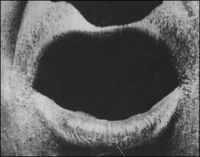Film
From The Art and Popular Culture Encyclopedia
| Revision as of 09:51, 13 April 2021 Jahsonic (Talk | contribs) ← Previous diff |
Revision as of 18:43, 7 May 2021 Jahsonic (Talk | contribs) Next diff → |
||
| Line 20: | Line 20: | ||
| "[[Romantic literature|Romantic authors]] such as [[Novalis]] or [[Jean Paul]], while anticipating the Expressionist notions of [[visual]] [[delirium]] and of a continual state of [[effervescence]], also seem almost to have foreseen the [[film|cinema]]'s consecutive sequences of images. In the eyes of [[Karl Wilhelm Friedrich Schlegel|Schlegel]] in ''[[Lucinde]]'', the loved one's features become indistinct: 'very rapidly the outlines changed, returned to their original form, then metamorphosed anew until they disappeared entirely from my exalted eyes.' And the [[Jean Paul]] of the ''[[Flegeljahre]]'' says: 'The invisible world wished, like chaos, to give birth to all things together; the flowers became trees, then changed into columns of cloud; and at the tops of the columns flowers and faces grew. In [[Novalis]]'s novel ''[[Heinrich von Ofterdingen]]'' there are even [[superimposition]]s."--''[[The Haunted Screen]]'' (1952) by Lotte H. Eisner | "[[Romantic literature|Romantic authors]] such as [[Novalis]] or [[Jean Paul]], while anticipating the Expressionist notions of [[visual]] [[delirium]] and of a continual state of [[effervescence]], also seem almost to have foreseen the [[film|cinema]]'s consecutive sequences of images. In the eyes of [[Karl Wilhelm Friedrich Schlegel|Schlegel]] in ''[[Lucinde]]'', the loved one's features become indistinct: 'very rapidly the outlines changed, returned to their original form, then metamorphosed anew until they disappeared entirely from my exalted eyes.' And the [[Jean Paul]] of the ''[[Flegeljahre]]'' says: 'The invisible world wished, like chaos, to give birth to all things together; the flowers became trees, then changed into columns of cloud; and at the tops of the columns flowers and faces grew. In [[Novalis]]'s novel ''[[Heinrich von Ofterdingen]]'' there are even [[superimposition]]s."--''[[The Haunted Screen]]'' (1952) by Lotte H. Eisner | ||
| <hr> | <hr> | ||
| - | "Any list of [[cult film]]s will include, by decade, ''[[Le Voyage dans la Lune]]'' (1902), ''[[The Cabinet of Dr. Caligari]]'' (1919), ''[[Un Chien Andalou]]'' (1929), ''[[Freaks (1932 film)|Freaks]]'' (1932), ''[[La Main du diable]]'' (1943), ''[[Les Vacances de Monsieur Hulot]]'' (1953), ''[[Peeping Tom (film)|Peeping Tom]]'' (1960), ''[[A Clockwork Orange (film)|A Clockwork Orange]]'' (1971), ''[[Videodrome]]'' (1983), ''[[Audition (film)|Audition]]'' (1999), ''[[Russian Ark]]'' (2002)and ''[[Joker (2019 film)|Joker]]'' (2019)."--Sholem Stein | + | "Any list of [[cult film]]s will include, by decade, ''[[Le Voyage dans la Lune]]'' (1902), ''[[The Cabinet of Dr. Caligari]]'' (1919), ''[[Un Chien Andalou]]'' (1929), ''[[Freaks (1932 film)|Freaks]]'' (1932), ''[[La Main du diable]]'' (1943), ''[[Les Vacances de Monsieur Hulot]]'' (1953), ''[[Peeping Tom (film)|Peeping Tom]]'' (1960), ''[[A Clockwork Orange (film)|A Clockwork Orange]]'' (1971), ''[[Videodrome]]'' (1983), ''[[Audition (film)|Audition]]'' (1999), ''[[Russian Ark]]'' (2002) and ''[[Joker (2019 film)|Joker]]'' (2019)."--Sholem Stein |
| |} | |} | ||
| [[Image:Arrival of a Train at La Ciotat, 1895.jpg|thumb|right|200px|This page '''''{{PAGENAME}}''''' is part of the [[film]] series.<br>Illustration: screen shot from ''[[L'Arrivée d'un train en gare de La Ciotat]]'']] | [[Image:Arrival of a Train at La Ciotat, 1895.jpg|thumb|right|200px|This page '''''{{PAGENAME}}''''' is part of the [[film]] series.<br>Illustration: screen shot from ''[[L'Arrivée d'un train en gare de La Ciotat]]'']] | ||
Revision as of 18:43, 7 May 2021

|
"The mainstream comes to you, but you have to go to the underground." -- Frank Zappa "They can keep their Bressons and their Cocteaus. The cinematic, modern marvelous is popular, and the best and most exciting films are, beginning with Méliès and Fantômas, the films shown in local fleapits, films which seem to have no place in the history of cinema." --Le Surréalisme au cinéma (1953) by Ado Kyrou “What are commonly called true cinephiles are mental retards (débile mentale) who love “the movies”, people who run to any theatre to submit to viewing any film. They consume with the same pleasure whatever genre of film. That is what is known as cinephilia. It’s an illness, though a less common one than it used to be [during the heydays of the Nouvelle Vague ]”. --Alain Robbe-Grillet The rise of cinema and "moving pictures" in the first decade of the 20th century gave the modern movement an artform which was uniquely its own. -- Sholem Stein, Dec 2004 "The Kino is a vulgar modern entertainment and I doubt if it can tell us anything serious about the modern condition [...]" --Sigmund Freud [ Cinema is] "a pastime for helots, a diversion for uneducated, wretched, worn-out creatures who are consumed by their worries . . ., a spectacle which requires no concentration and presupposes no intelligence . . ., which kindles no light in the heart and awakens no hope other than the ridiculous one of someday becoming a 'star' in Los Angeles."--Scènes de la vie future (1930) by Georges Duhamel "With the arrival of cinema, French philosopher Henri Bergson felt the need for new ways of thinking on movement and coined the terms "image-temps" and "image-mouvement" in Matter and Memory (1896). Gilles Deleuze, another French philosopher, took Matter and Memory to explain his views in his Cinéma I & II (1983-1985)." --Sholem Stein "Romantic authors such as Novalis or Jean Paul, while anticipating the Expressionist notions of visual delirium and of a continual state of effervescence, also seem almost to have foreseen the cinema's consecutive sequences of images. In the eyes of Schlegel in Lucinde, the loved one's features become indistinct: 'very rapidly the outlines changed, returned to their original form, then metamorphosed anew until they disappeared entirely from my exalted eyes.' And the Jean Paul of the Flegeljahre says: 'The invisible world wished, like chaos, to give birth to all things together; the flowers became trees, then changed into columns of cloud; and at the tops of the columns flowers and faces grew. In Novalis's novel Heinrich von Ofterdingen there are even superimpositions."--The Haunted Screen (1952) by Lotte H. Eisner "Any list of cult films will include, by decade, Le Voyage dans la Lune (1902), The Cabinet of Dr. Caligari (1919), Un Chien Andalou (1929), Freaks (1932), La Main du diable (1943), Les Vacances de Monsieur Hulot (1953), Peeping Tom (1960), A Clockwork Orange (1971), Videodrome (1983), Audition (1999), Russian Ark (2002) and Joker (2019)."--Sholem Stein |

Illustration: screen shot from L'Arrivée d'un train en gare de La Ciotat


|
Related e |
|
Featured: |
Film is a visual art used to simulate experiences that communicate ideas, stories, perceptions, feelings, beauty, or atmosphere through the use of moving images. These images are generally accompanied by sound, and more rarely, other sensory stimulations. The word "cinema", short for cinematography, is often used to refer to filmmaking and the film industry, and to the art form that is the result of it.
The moving images of a film are created by photographing actual scenes with a motion-picture camera, by photographing drawings or miniature models using traditional animation techniques, by means of CGI and computer animation, or by a combination of some or all of these techniques, and other visual effects.
Traditionally, films were recorded onto celluloid film stock through a photochemical process and then shown through a movie projector onto a large screen. Contemporary films are often fully digital through the entire process of production, distribution, and exhibition, while films recorded in a photochemical form traditionally included an analogous optical soundtrack (a graphic recording of the spoken words, music and other sounds that accompany the images which runs along a portion of the film exclusively reserved for it, and is not projected).
Films are cultural artifacts created by specific cultures. They reflect those cultures, and, in turn, affect them. Film is considered to be an important art form, a source of popular entertainment, and a powerful medium for educating—or indoctrinating—citizens. The visual basis of film gives it a universal power of communication. Some films have become popular worldwide attractions through the use of dubbing or subtitles to translate the dialog into other languages.
The individual images that make up a film are called frames. In the projection of traditional celluloid films, a rotating shutter causes intervals of darkness as each frame, in turn, is moved into position to be projected, but the viewer does not notice the interruptions because of an effect known as persistence of vision, whereby the eye retains a visual image for a fraction of a second after its source disappears. The perception of motion is partly due to a psychological effect called the phi phenomenon.
The name "film" originates from the fact that photographic film (also called film stock) has historically been the medium for recording and displaying motion pictures. Many other terms exist for an individual motion-picture, including picture, picture show, moving picture, photoplay, and flick. The most common term in the United States is movie, while in Europe film is preferred. Common terms for the field in general include the big screen, the silver screen, the movies, and cinema; the last of these is commonly used, as an overarching term, in scholarly texts and critical essays. In early years, the word sheet was sometimes used instead of screen.
Contents |
In the history of fiction
In the history of fiction, film became the dominant medium after the arrival of sound film in the late 1920s and early 1930s, displacing the novel and theatre. Until the arrival of home video, film was a community based entertainment medium. In recent years, video games have displaced films as the top grossing entertainment medium.
History
Motion pictures developed gradually from a carnival novelty to one of the most important tools of communication, entertainment, and mass media in the 20th century. Films have had a substantial impact on the arts, technology, and politics.
Cinema
Cinema is synonym for film. The word borrows from French cinéma, shortening of cinématographe (term coined by the Lumière brothers in the 1890s), from Ancient Greek κίνημα (kínēma, “movement”)
Bibliography
- The Hollywood Hallucination (1944) by Parker Tyler
- The Haunted Screen (1952) by Lotte Eisner
- Le Surréalisme au cinéma by (1953) Ado Kyrou
- Hollywood Babylon (1959) by Kenneth Anger
- Film as a Subversive Art (1974) by Amos Vogel
- Visual Pleasure and Narrative Cinema is a feminist film essay by British academic Laura Mulvey, written in 1973 and first published in 1975
- Midnight Movies (1983) by J. Hoberman and Jonathan Rosenbaum
- Incredibly Strange Films (1986) by by V. Vale and Andrea Juno
- Cult Movie Stars (1991) by Danny Peary
- Immoral Tales: European Sex & Horror Movies 1956-1984 (1994) by Cathal Tohill and Pete Tombs
- 1001 Movies You Must See Before You Die (2004)
- The Pervert's Guide to Cinema (2006) is a two-hour documentary by Sophie Fiennes, scripted and presented by Slavoj Žižek.
See also
- Cinematic techniques
- Cinephilia
- Cinematography, the art of recording visual images
- Cinematic effects in literature
- Experiments with cinematic time
- History of fiction
- Jahsonic's film canon
- List of film topics
- Lists of films
- Lost film
- Paracinema
- Sequential art
- Visual culture


